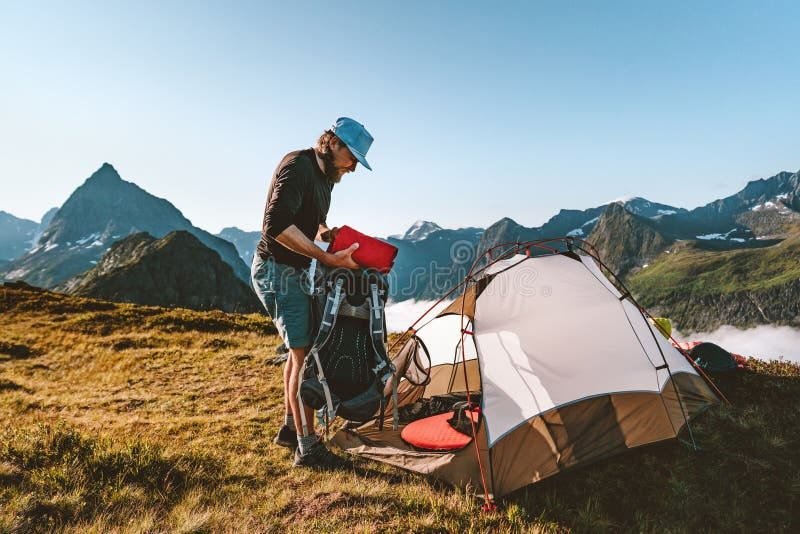The Night I Almost Quit Backpacking (And How One Gear Change Saved My Trail Dreams) | by National Park Diary | Jul, 2025

That magical moment when camp becomes home for the night
Mile 847 of the Pacific Crest Trail. I collapsed beside my pack, every muscle screaming in protest as I surveyed the rocky campsite. My shoulders felt like they’d been worked over with a sledgehammer, and I still had to set up camp before darkness swallowed the mountains. As I reached for my heavyweight tent — a beast that had served me well on car camping trips but felt like pure torture on my back — I whispered the words I never thought I’d say: “Maybe I’m not cut out for this.”
My backpacking journey began like many others — with enthusiasm that far exceeded my knowledge. I’d invested in what I thought was quality gear: a sturdy four-season tent that could withstand a hurricane, a sleeping bag rated for temperatures I’d never encounter, and enough “just in case” items to stock a small outdoor store. My base weight? A crushing 35 pounds before adding food and water.
Three days into my PCT section hike, reality hit harder than the California sun. Every step felt like punishment. My knees ached by noon, my back spasmed by evening, and my spirit deflated with each labored breath. Other hikers seemed to glide past me with seemingly effortless grace, their packs looking nearly empty compared to my monstrous burden.
“That tent alone weighed 6.5 pounds — more than some hikers’ entire shelter system. I was carrying my fears instead of following my dreams.”
Everything changed when I met Tom, a weathered thru-hiker taking a rest day at Crater Lake. While I struggled to extract my tent from its oversized stuff sack, he quietly assembled what looked like a minimalist masterpiece using nothing but his trekking poles and a gossamer-thin fabric that weighed less than a paperback novel.
The gear that transforms both your pack and your perspective
“What’s your base weight?” Tom asked, eyeing my expedition-sized pack.
When I sheepishly admitted thirty-five pounds, he didn’t laugh or judge. Instead, he sat down and shared something that would fundamentally change my relationship with the wilderness: the philosophy of ultralight backpacking.
“Every ounce you don’t carry is an ounce of energy you can spend enjoying the trail instead of suffering through it.”
Tom introduced me to a concept I’d never considered: using trekking poles as tent supports. His shelter system epitomized elegant simplicity — dual-purpose gear that eliminated redundancy while maximizing performance. Instead of carrying separate tent poles that served only one function, his trekking poles pulled double duty as hiking aids and structural support for his shelter.
The mathematics were stunning. By switching from my traditional tent to a trekking pole design, I could instantly shed 3–4 pounds from my pack weight. But the benefits extended far beyond mere numbers. These ultralight shelters offered superior wind resistance due to their aerodynamic profiles, faster setup times once mastered, and compact pack sizes that freed up precious space for other essentials.
The beautiful simplicity of ultralight gear organization
Six months later, I returned to the trail with a completely transformed pack. My new trekking pole tent weighed just 1.8 pounds compared to my previous 6.5-pound behemoth. The difference was immediately apparent — not just in the reduced strain on my body, but in my entire hiking experience.
Where I once dreaded the end of each hiking day, I now looked forward to the ritual of making camp. Setting up my trekking pole shelter became a meditative practice that connected me more intimately with my environment. I learned to read terrain for optimal pitching sites, to work with natural windbreaks, and to achieve that perfect tension that turns a simple fabric into a secure home.
The learning curve wasn’t trivial — trekking pole tents require more attention to setup details than freestanding alternatives. But this engagement enhanced rather than detracted from my outdoor experience. Each successful pitch felt like a small victory, a mastery of skill that deepened my connection to the wilderness craft.
The most profound change wasn’t physical — it was psychological. Shedding those excess pounds didn’t just lighten my pack; it lifted my spirits and expanded my horizons. Suddenly, longer distances became achievable. Remote destinations that once seemed impossibly far became reasonable objectives. My daily mileage increased naturally as hiking became less about endurance and more about enjoyment.
I discovered that ultralight backpacking is ultimately about optimization rather than deprivation. It’s a mindset that questions every item, seeking gear that serves multiple purposes while delivering maximum performance per ounce. This philosophy extends beyond equipment to encompass route planning, food strategies, and even how you approach challenges on the trail.
- ✓Weight savings of 2–4 pounds compared to traditional tents
- ✓Superior storm-worthiness due to aerodynamic design
- ✓Compact pack size creates more storage flexibility
- ✓Lower long-term costs (no tent poles to replace)
- ✓Enhanced connection with outdoor skills and environment
My transformation from struggling weekend warrior to confident ultralight hiker opened doors I never knew existed. Long-distance trails that once seemed reserved for superhuman athletes became achievable goals. Remote wilderness areas accessible only through extended backpacking trips appeared on my radar as realistic destinations.
More importantly, I discovered that the principles of ultralight backpacking — intentionality, efficiency, and optimization — applied to life beyond the trail. The discipline of questioning whether each item earned its place in my pack translated to a broader mindfulness about what truly added value to my experiences.
Today, five years after that pivotal night when I almost quit backpacking, I’ve completed multiple thru-hikes and logged thousands of trail miles. My trekking pole tent has been my constant companion through desert storms in the Mojave, snow squalls in the Sierra Nevada, and countless peaceful evenings under star-filled skies.
If you’re struggling with pack weight or questioning whether you have what it takes for longer backpacking adventures, know that gear optimization can be genuinely transformative. The difference between carrying a brutal load and hiking with efficient, purposeful equipment often determines whether backpacking becomes a lifelong passion or a short-lived experiment.
Trekking pole tents represent one of the most impactful upgrades any backpacker can make. They embody the core principles of ultralight philosophy: dual-purpose functionality, weight optimization, and enhanced performance. While they require a modest investment in learning proper setup techniques, the payoff in hiking enjoyment and expanded possibilities is immeasurable.
Whether you’re a struggling beginner like I once was or an experienced hiker looking to optimize your kit, exploring ultralight shelter options could be the catalyst that transforms your relationship with the wilderness. Sometimes, the difference between dreading and loving the trail comes down to the weight on your shoulders and the gear that either supports or burdens your adventures.
Ready to revolutionize your backcountry experience? Discover everything you need to know about choosing, setting up, and maximizing the performance of these ultralight shelters in this comprehensive guide to trekking pole tent mastery.

